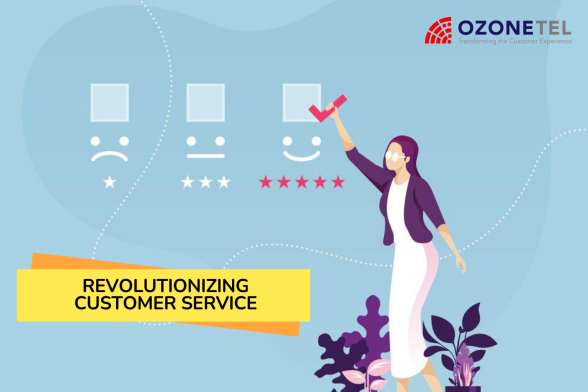- Resources
- Revolutionizing Customer Service
Revolutionizing Customer Service

Your customers are different now.
The events of the past year and a half have taken a toll on everyone. This time has altered the way we work, socialize, and live our lives.
As it turns out, it’s altered the way customers want to interact.
This isn’t a small shift. It’s completely revolutionizing customer service.
In this article, we will explore:
The Changing Nature of Customer Service
Have you noticed a difference in customer behavior patterns? In our CX study 2020-21, we have explored how customer interactions have changed. This and other studies have shown some big changes in today’s customer behavior that has a direct impact on what they expect from customer service.
Your customers are more proactive
Consumers are far more proactive now.
There’s even a term for it. The “Self-Directed Customer.”
They prefer to control their interactions as far as possible. They like to guide themselves through interactions, opting for chat options over waiting on a phone. And they like self-help guides and community-based information sharing.
They want text alerts to keep them in the loop.
They’re more Digital
They’re also vocal and social. They reach out on different platforms, are active on social media, and are highly communicative.
They like to share everything about their lives – including their experiences with your company. They often have conversations about brands without directly addressing the company.
These customers are self-oriented in their relationship. They want quick attention, with personalized service responses.
And the results show.
For instance,
And possibly, a little needier than you think
After analyzing the data from 150 million calls, there’s one fundamental conclusion. From time to time, customers need human interactions.
They want to talk to with your agents. And they’ll spend more time doing so.
People are hungry for human-to-human interactions. Today, customers are three times more likely to answer your calls. But they’re also impatient. On an average, 15% aren’t willing to wait when time in a call queue exceeds an average of 37 seconds.
Meeting their needs requires leveraging the cloud and other emerging technologies.
The Technology Revolutionizing Customer Service
Not all of these technologies are new. But Covid-19’s digital acceleration also led to increased innovation and new (more practical) use cases.
Leveraging technology requires a solid foundation, a well-integrated tech stack, and keeping close watch over your operations.
Cloud Solutions
Resilience is in the cloud. When Covid-19 hit, companies operating on cloud-based architecture were better prepared for social distancing mandates.
Those relying on on-premises infrastructure had to race to implement emergency continuity solutions.
Entire call centers can be effectively dispersed if need be. Secure cloud solutions facilitate seamless service whether agents are working in-office, at-home, or hybrid hours.
These include built-in features that are revolutionizing contact center customer service. Remote performance monitoring, disaster recovery, data protection, and role-based access protect business interests while agents work from home.
Scalable cloud solutions bring operational flexibility and agility. With ongoing regional disruptions, tech-forward customer service centers are optimizing resources by managing fluctuating customer demands and labor needs with cloud solutions.
But cloud solutions do more than enable location independence in a crisis. On-premises data servers are difficult to scale, expensive to run, and quickly become outdated.
Managing bulky legacy systems can cost organizations into the millions. Shifting to cloud infrastructure immediately frees these resources, implements the latest security measures, and enables compatibility with new technological innovations.
Secure, interoperable cloud infrastructure is the foundation for growth, efficiency, and continued innovation.
Cloud-Native Contact Center Software
Taking this one step further is cloud-based contact center software as a service (CCaaS).
CCaaS provides all the resilience and scalability of the cloud while delivering the latest, cutting-edge customer care technology as an all-inclusive service.
The efficiency of the cloud can’t be overstated.
There’s no investment in IT services, hardware, security patches, or ongoing maintenance. And it eliminates the risk of being tied to obsolete, high-cost technologies.
Not only will the right CCaaS immediately bring your center up to date with the latest standards…
…It future proofs your customer service operations.
How rapidly can you update your IVR software to feature the latest conversational AI? With CCaaS, these changes are instantly implemented across your service center.
Keeping up with the latest in speech analytics or ACD (automatic call distribution) tech advances shouldn’t be your job.
An advanced contact center solution stays current with key industry developments, tech improvements, and security measures.
Also Read: Our complete guide to CCAAS & whether you should invest in it.
CRM Software
The typical CRM used to be a database for lead tracking, contact management, and storing customer-related facts.2 Basic automation was the first widely adopted innovation.
The real innovation in this sector was sparked by the growing wealth of customer data from social media interactions and ubiquitous smartphone use.
Analytics turned this data into insights. And with these insights, came customer care intelligence.
Customer care intelligence introduced the customer-centric approach, with a shift to relationship building and personalization.
CRMs are now essential for maximizing the value of customer care intelligence. Once integrated into business activities, they can drive growth by up to 30 percent. 3
The introduction of artificial intelligence has once again revolutionized this area of customer service.
AI-based customer care intelligence can deliver insights on everything from lead qualification to sales forecasting to content recommendations.
Organizations that already have their CRMs connected to their main customer experience platform are at an advantage here.
Artificial Intelligence
Artificial intelligence isn’t limited to CRMs. Machine learning is working its way into every software solution.
Gartner estimates that by 2022, 70% of all customer interactions will incorporate machine learning and other emerging new technologies.
AI can take over manual labor, rapidly process data, and act as a virtual assistant. This in itself makes it vital.
According to IBM, at least 80% of all business data is “unstructured”. This is data related to customer behavior and intent.
Unstructured data can’t be processed with standard tools. It needs natural language processing, text mining, sentiment analysis, and advanced data science.
But AI’s ability to peer into human behavior, garner insights from our patterns, and detect our individual variances might be its most invaluable contribution.
MIT’s Technology Review notes how this is revolutionizing customer service. AI is now powerful enough to understand and predict our desires before we consciously recognize them.
It can be integrated into every area of customer service, working independently and alongside human agents.
Yes, the long-feared robot takeover is happening.
But instead of replacing us, AI’s current iteration only serves to enhance our capabilities, shore up any weak spots, and complement our strengths.
If AI’s contributions can be effectively linked to other activities, the business value will be unprecedented.
- Prescriptive insights should be incorporated into customer profiles.
- Real-time sentiment analysis monitoring can trigger contextual outreach campaigns.
- Predictive lead scoring should be used to distribute resources more effectively.
The Omnichannel Customer Service Revolution
Your customers are digitally omnipresent. They’re always connected, use a range of devices, and are active across several platforms.
Do you know what’s being said about your brand on social media? How quickly can your agents respond to unfolding conversations on any platform?
Your customer service needs to be omnichannel. And this means more than simply being active on social media or sending out SMS notifications.
Can your customer care intelligence track customers who start a conversation on their smartphone, switch to a work device, then move to a personal tablet?
With omnichannel customer service, every interaction seamlessly connects, with deep integration into your customer care intelligence platform.
This is revolutionizing customer service.
How Starbucks Revolutionized their Customer Service
Starbucks is an example of fluid, omnichannel customer service at its finest. Loyal customers have accounts they can access through the main website or via an app.
They can find evaluate nearby stores, place orders, save their favorite drink customization, and send or receive gifts. They can even make in-store payments using their phone.
A Spotify integration makes things even more engaging by telling customers what music is playing inside the store.
Starbucks also entices casual users to sign-up by featuring rewards points on the coffee it sells in supermarkets.
Every company doesn’t need to be Starbucks. But putting the omnichannel basics in place is essential for customer service best practices.
Your digital channels should at least be integrated with your customer care intelligence platform.
The New Customer Service Best Practices
There’s a new set of customer service best practices. The cloud is non-negotiable, everything must integrate, metrics matter, train for consistency, and scale to greatness.
Switch to the Cloud
McKinsey places the value of cloud use at over $1 trillion4. Around $430 billion comes purely from cost optimization, increased business resilience, and digitization.
A further $770 billion comes from new innovations, higher computing power, accelerated product development, improved operating models, and hyper-scalable service delivery.
Cloud environments inherently favor growth, innovation, and resource efficiency. It’s where fast-moving, competitive organizations thrive.
One logistics company increased its operational efficiency by 40%. Their cloud shift was more than an infrastructure update. It brought in new capacities for delivering a great customer experience.
Moving operations from on-premises architecture to a secure cloud environment opens the door to accelerated growth, value generation, and competitive readiness.
This process doesn’t need to be disruptive or sudden. Cloud solutions can be used to augment existing on-premises servers while undergoing a gradual, more gentle digital transition.
Integrate
Retain full control over operations with one central, controlling platform. This hub should facilitate full interoperability between solutions.
The data, insights, and customer care intelligence generated across multiple solutions can be brought into one cohesive picture.
Siloed tools and information waste resources and squander the potential to deliver value. CRM data has no value if it can’t be routed towards agents in-call.
And there’s nothing more frustrating to a customer, than having to repeat information to agents within the same organization.
A platform with open API architecture can integrate your CTI, CRM, digital communication channels, business intelligence, and even custom-built tools.
Instead of a disparate tech array, this creates a far more useful gestalt with true intelligence.
The latest tools, innovation, and AI are only as useful as they are practical. Integrating your stack into a control platform gives you total command.
Monitor and Measure
The cloud removes the guessing game. Everything can be tracked, monitored, and measured.
That means agents, customers, and conversational effectiveness.
AI-based speech analytics can automatically monitor interactions without human intervention. And auto-logging chats and calls preserves them for future review.
But cloud capabilities go beyond basic tracking and reporting.
What are your key metrics? These can be built into your custom software solution’s configuration.
Analytics, machine learning, and AI’s predictive capabilities can continually optimize operations towards the desired business objective.
Train and Scale
Customer experience can’t be left to chance. Maintaining a consistent brand experience across channels and agents is essential.
Thorough agent training followed up with ongoing quality control measures will create continuity at every customer touchpoint.
Leveraging emerging technologies will radically improve agent training and support capabilities. AI insights and customer care intelligence should be used to inform agent training.
Once trained, AI can monitor agents for service quality, analyze their interactions, and retrain when necessary to optimize care delivery.
With artificial intelligence-powered checks and balances, operations can be scaled out without the fear of costly human error mistakes.
Analyzing over 150 million customer service calls revealed that experienced agents close their calls 20% faster than new agents.
Highly trained agents are a core factor in keeping operations efficient and optimized.
Conclusion
So, what’s revolutionizing customer service? ultimately, it’s your customers and what they want.
McKinsey calls this “hyperpersonalized care” and “care of one.”
Personalization, empathy, connectedness, and attention. These customer desires are expected to deepen. And they must be met at scale.
It’s no longer possible to give customers the experience they want with old tech.
However, this rare black swan crisis comes at a time when several emerging technologies are ready for mainstream adoption.
Digital-savvy groups have fared the best. Agility is the difference between resilient continuity versus going into survival mode. The best companies are thriving.
Augmenting dated legacy infrastructure with cloud-based systems helped others with the immediate need to stay afloat.
But using the cloud to patch over or shore up old technology won’t stave off the inevitable. Remaining competitive and viable in this customer service revolution depends on reliable, scalable, cloud-native operations.
Sources:
The Complete History of CRM – Salesforce







